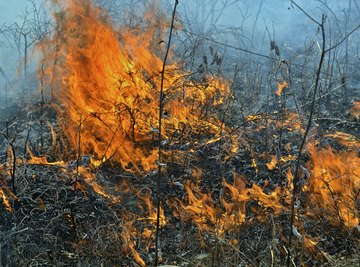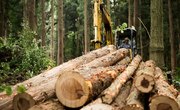
Some 100,000 wildfires torch approximately 16,000 to 20,000 square kilometers (6,177 to 7,700 square miles) of land every year in the United States, and the average fire costs $30,000 to put out -- though some cost millions. Lightning starts many fires, but human negligence is responsible for many more. Smokey Bear, the U.S. Forest Service mascot, says that only you can prevent forest fires, and that's true on an individual and collective level.
Equipment Safety
Tools that you use to manage weeds, cut grass and trim trees are all capable of starting fires. You should always keep a safe distance from trees and dry grass when using tools that produce sparks, such as grinders and metal-cutting saws. All gasoline-powered tools, such as weed whackers, chainsaws, lawn mowers and electric generators, should have spark arrestors, which are screens that prevent the emission of sparks from the exhaust outlets. Be careful never to spill fuel or oil in the forest, and when driving in dry forest terrain, keep your vehicle on the road. This specifically applies to all-terrain vehicles, which some people assume are safe to drive through a dry forest. They aren't; the heat from the exhaust can ignite grass and brush.
Responsible Burning
Whenever you are hiking or camping, you should set fires only in designated camping areas, and it's vital to make sure your campfire is "dead out" before leaving your campsite. You should never discard smoldering or burning objects in the forest -- even if you think there is no danger. Never throw cigarettes away; butt them out and keep them with you until you can dispose of them safely. Homeowners who burn trash or brush in their back yards should only do so when local ordinances allow it -- if your local fire authority requires a permit, make sure you get one and that you notify the fire department when the burn happens. That ensures a quick response if something goes wrong.
Protecting Your Home
If you are a homeowner who lives near forested land, you should take steps to safeguard your home from an advancing fire. Maintain 100 feet of defensible space around your home by raking leaves, clearing brush and pruning tree limbs. Keep the grass short, and remove any vegetation from your house, such as vines. Clear a 10-foot space around any fuel storage area, such as tool sheds and propane tanks. Keep flammable waste, such as newspapers and other rubbish, to a minimum by regularly taking it to a disposal area, and stack your firewood at least 100 feet from the house.
Computer-Assisted Fire Prevention
While it's vitally important for individuals to take steps to prevent fires, it's also important to adopt prevention strategies at the collective level. Forestry personnel use computer simulations to help them understand how small fires turn into large ones, and by inputting typical wind patterns, available fuel and other parameters, they get an idea of the effects of a lightning strike in a particular area. They can then strategically apply manpower and resources to modify the effects. Some techniques they use are brush clearing, branch trimming and strategic grass fires that create buffer zones around vulnerable forest stands.
References
About the Author
Chris Deziel holds a Bachelor's degree in physics and a Master's degree in Humanities, He has taught science, math and English at the university level, both in his native Canada and in Japan. He began writing online in 2010, offering information in scientific, cultural and practical topics. His writing covers science, math and home improvement and design, as well as religion and the oriental healing arts.
Photo Credits
KirsanovV/iStock/Getty Images
